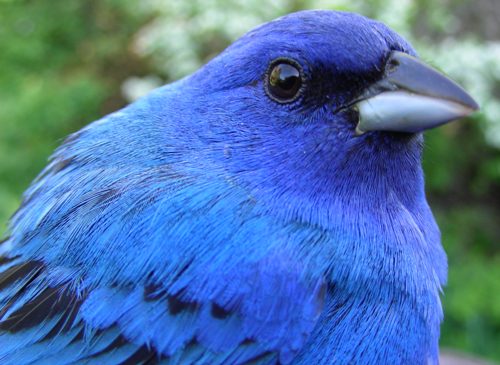|
|
THIS WEEK |
THIS SPRING |
2008 TOTAL |
SITE TOTAL |
|
# birds (and species) banded |
171 (30) |
772 (63) |
772 (63) |
13750 (105) |
|
# birds (and species) repeat |
41 (14) |
188 (25) |
188 (25) |
2414 (60) |
|
# birds (and species) return |
8 (4) |
90 (17) |
90 (17) |
421 (30) |
|
# species observed |
101 |
136 |
137 |
193 |
|
# net hours |
446 |
2790.7 |
2790.7 |
24736.5 |
|
# birds banded / 100 net hours |
38.3 |
27.7 |
27.7 |
55.6 |
|
|
Note: table does not include nocturnal banding (owls) |
Bander-in-charge: Marie-Anne Hudson
Assistants: Jean Beaudreault, Louise Bédard, David Bird, Anne Chen, Dave Davey, Samuel Denault, Andréanne Deschamps, Simon Duval, David Fishman, Nicky Fleming, Gay Gruner, Demetrios Kobiliris, Céline Lecomte, Helen Leroux, Barbara MacDuff, Mike Mayerhofer, Chris Murphy, Kathleen Sary, Rodger Titman
The annual
MBO Birdathon was held on Saturday, May 25. Click
here for a full report. |
Notes: It was during this week last year that we banded our 10000th bird, a TY female Hairy Woodpecker. We’re creeping ever closer to the 14000 mark, though it will likely have to wait until next fall unless the nets suddenly begin teeming with birds over the next week. Many other landmarks/records were smashed this week though, with a huge influx of migrants on the night of the 25th. We have now banded more birds than during any other spring season (despite closing our nets for the Baillie Birdathon and having some very fierce winds to contend with), we tied our busiest spring day ever with 57 birds banded (same as May 16th 2005 but with one less species), and banded more Wilson’s Warblers in one week than in any previous spring season! Although not *quite* a record, it's also worth pointing out this is only the second time we've observed over 100 species in a week (the other being week 8 in spring 2006, when we tallied 104). Last year at this time migration was showing clear signs of winding down, but this year it's still going strong, with only a few days of banding left until the end of the season.
Eight species were added this week to the season/year list: Gadwall, Black-billed Cuckoo, Eastern Wood-Pewee, Yellow-bellied Flycatcher, Traill’s Flycatcher, Bank Swallow, American Pipit, Mourning Warbler, and eight species were added to our newly banded for the season list (Traill’s Flycatcher, Swainson’s Thrush, Red-eyed Vireo, Mourning, Canada, Blackpoll and Bay-breasted Warblers - our first spring bay-breasted ever! - and Indigo Bunting), bringing it up to 63, which ties the high we set in 2006. It should be noted though that spring species totals have been very consistent over our three previous years, ranging only from 61 to 63. A few days remain to see whether we can make it to 64 for the first time.
This week has been hugely exciting with all the birds around, but also incredibly exasperating! The wind has enabled several birds to escape as the pockets ballooned open, and a few very special birds have either hit the net and bounced (Sharp-shinned Hawk and American Crow – those of you who know crows know that they NEVER get caught in mist-nets…and we were so close…), or have skirted within inches of a net without getting caught (Virginia Rail that scooted across the path at C2). Luckily, we’ve also had many warblers to keep us happy, and our breeders have really gotten down to business: Yellow Warbler and Baltimore Oriole nests have popped up almost everywhere, and the female Red-winged Blackbirds, Common Grackles, Song Sparrows and even a Chipping Sparrow and a White-throated Sparrow, have gigantic brood patches designed to keep their eggs warm.
This week’s top 10 banded species list has changed drastically from last week, reflecting the wave of warblers coming through. Despite the influx, Red-winged Blackbirds reclaimed their top spot, with Wilson’s and Blackpoll Warblers in hot pursuit. Though the Blackpoll numbers don’t begin to compare to last year, most of the 17 banded were within the space of two days, making us feel like every other bird banded was a Blackpoll. A group of about 16 Cedar Waxwings has decided to hang around as well, teaching us that waxwings are not very adept at avoiding nets. We were sure we’d banded most of the flock by now, but they just keep coming and we have yet to recap any of them. Yellow Warblers slipped out of their top spot, their migration slowing down with mostly just local breeders remaining. Virtually all the Northern Waterthrushes, tied with American Goldfinch for the last spot in the top 10, were banded on the same day as well, highlighting the wave effect that migration can appear to have.
Canada Goose has resurfaced on this week’s top 10 observed species list, but well behind the other usual suspects that have simply shuffled around. It should be specified though, that their position within the table is largely due to the brood of seven goslings seen every day. Their number will of course be removed for the purpose of our migration monitoring, since they’re obviously not migrants (yet)! The arrival of the flock of Cedar Waxwings is highlighted by their appearance on the list as well – perhaps they’ll remain on site and decide to breed come July?
|
This week's
top 10 [last week's rank in brackets] |
|
#
individuals banded |
mean #
individuals observed daily |
|
1. Red-winged Blackbird (21) [2] |
1. Red-winged Blackbird (41) [1] |
2. Wilson's Warbler (19) [-] |
2. Cliff Swallow (32) [3] |
|
3. Blackpoll Warbler (17) [-] |
3. Ring-billed Gull (18) [6] |
|
4. Cedar Waxwing (11) [-]
Magnolia Warbler (11) [7]
|
4. Yellow Warbler (17) [2] |
|
5. Tree Swallow (15) [5] |
|
6. American Crow (14) [4] |
|
6. Common Yellowthroat (10) [6] |
7. Canada Goose (13) [-] |
7. Yellow Warbler (9) [1]
Yellow-rumped Warbler (9) [3] |
8. American Goldfinch (10) [7] |
9. American Goldfinch (8) [5] Northern Waterthrush (8) [-] |
9. Cedar Waxwing (9) [-] |
|
10. Common Grackle (8) [10] |
|
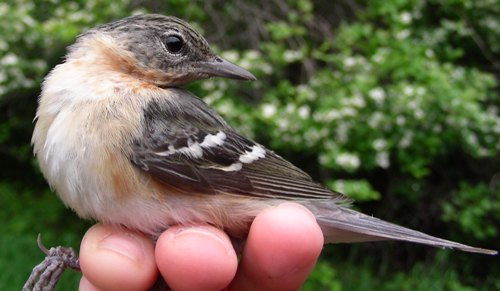
This second-year female Bay-breasted Warbler is the first one we’ve ever banded in spring, and only one of 10 ever banded at MBO!
(Photo by Marie-Anne Hudson)
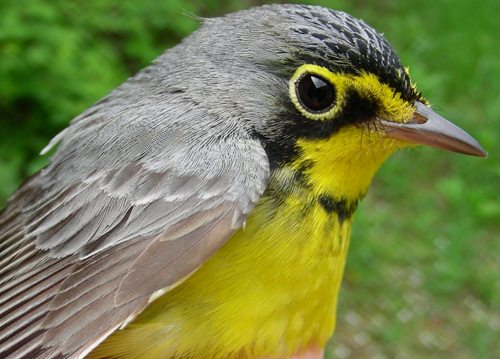
We counted about eight Canada Warblers this week, including the three we banded. This species has recently been designated as being threatened in Quebec, so we’re keeping a special eye out for them (Photo by Marie-Anne Hudson)
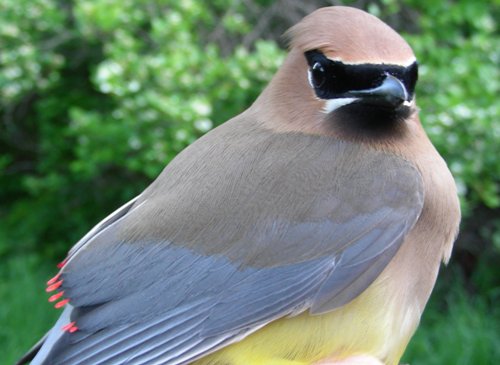
This after-second-year male Cedar Waxwing felt as soft as he looked
(Photo by Marie-Anne Hudson)
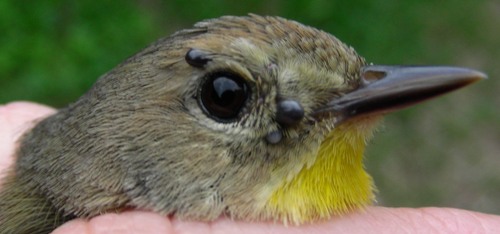
This second-year female Common Yellowthroat benefited from some tick removal – four of them to be precise – which are now winging their way to Ontario for inclusion in the Tick Project that we’re assisting with. We’re sure she felt much better with these critters removed from around her eye! (Photo by Marie-Anne Hudson) |

